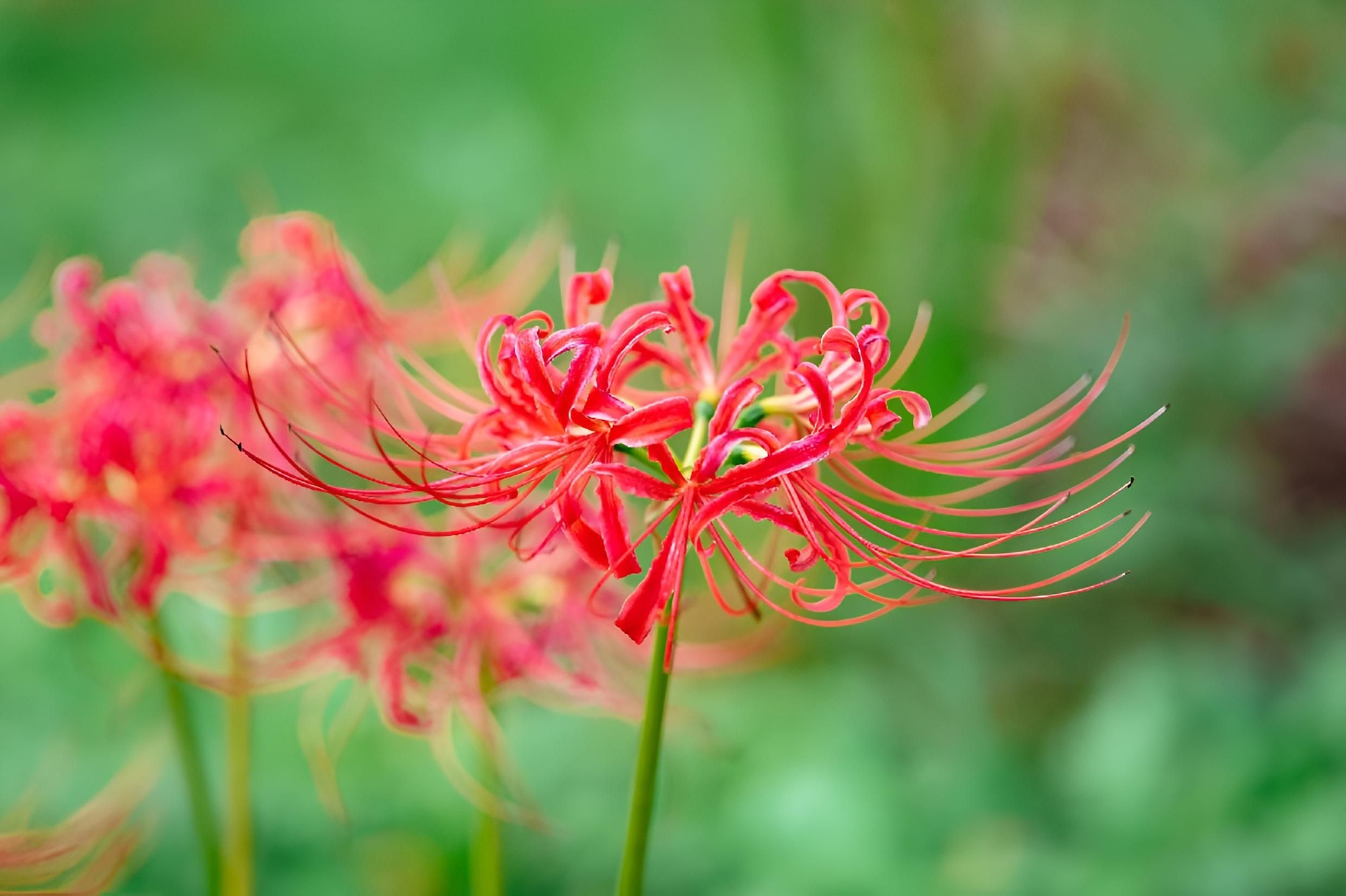The red spider lily (Lycoris radiata), often called the “flower of death,” is steeped in rich symbolism, cultural significance, and fascinating lore. These vibrant red flowers, with their spider-like petals and long stamens, have captured imaginations across Japanese and Chinese culture and beyond. Known for blooming during the autumnal equinox, they are closely associated with themes of death, rebirth, and the transient nature of life.
Characteristics of Red Spider Lilies
The red spider lily is a bulbous perennial plant with unique traits that distinguish it from other lilies:
- Appearance: The flower’s vibrant red petals resemble spider legs, giving it its name.
- Bloom Period: Red spider lilies bloom in late summer to early fall, often triggered by heavy rainfall.
- Toxicity: The bulbs of Lycoris radiata contain alkaloids such as lycorine, making them poisonous if ingested. This property led to their planting near graveyards and rice paddies to deter pests.
- Cultural Names: Known as Higanbana in Japanese, meaning “flower of the equinox,” they are deeply tied to Buddhism and traditional ceremonies.
Symbolism of Red Spider Lilies
Associated with Death and the Afterlife
The red spider lily is often seen as a flower of death, guiding souls to the afterlife. In Japanese culture, they are planted along graveyards and roads to prevent the dead from wandering. Their connection to death stems from the following:
- Higanbana: The Japanese name reflects their bloom during the autumn equinox, a time when the boundary between the living and dead is believed to thin.
- Funeral Flowers: Their association with grief and remembrance makes them a frequent sight at funerals and memorials.
Symbol of Rebirth and the Transient Nature of Life
The flower represents the impermanence of life and the cycle of rebirth. Their fleeting beauty mirrors the transient nature of existence, often reminding us to cherish life’s moments. In Buddhist teachings, they symbolize letting go and embracing the present.
Legends and Myths Surrounding Red Spider Lilies
“Never Meet Again” Legend
One of the most famous stories associated with red spider lilies tells of two lovers cursed to part forever. The flower symbolizes their eternal separation, embodying melancholy and unfulfilled longing.
Guide for the Dead
In Japanese and Chinese folklore, red spider lilies bloom along paths to guide the souls of the dead. This belief has earned them the nickname “corpse flower.”
Cultural Significance in Japan and China
Use in Ceremonies
- Autumnal Equinox: The flowers are used in rituals to honor ancestors and celebrate the arrival of fall.
- Tribute to the Dead: Red spider lilies are often placed on graves as a tribute to departed loved ones.
Appearance in Media
Red spider lilies have become iconic symbols in modern culture, appearing in anime like Demon Slayer and Tokyo Ghoul, where they signify death and rebirth.
How to Grow and Care for Red Spider Lilies
For gardeners drawn to their beauty and symbolism, red spider lilies can add a striking touch to landscapes:
- Planting Bulbs:
- Choose a well-drained location with full to partial sunlight.
- Plant bulbs in late summer for autumn blooms.
- Care Tips:
- Water regularly after planting, as blooms are triggered by rainfall.
- Avoid planting near children or pets due to the plant’s toxicity.
- Ideal Locations:
- Along pathways, creating a striking visual effect during full bloom.
Similar Flowers and Their Meanings
Blue Spider Lily
Rare and mystical, the blue spider lily is often featured in myths and represents impossible longing.
White Flowers
- White lilies: Symbolize purity and innocence, often used in funerals.
- Lotus: Represents rebirth and spiritual enlightenment in many cultures.
Other Red Flowers
- Red Roses: Signify deep love and passion.
- Marigold: Associated with remembrance and grief in Day of the Dead traditions.
The Red Spider Lily in Spirituality
The spiritual meaning of red spider lilies extends beyond their association with death:
- Rebirth and Renewal: They remind us of life’s cyclical nature.
- Guiding Souls: A representation of spiritual connection with those who have passed.
- Meditation on Impermanence: Encourages contemplation of life’s fleeting beauty.
Interesting Facts About Red Spider Lilies
- Scientific Name: Lycoris radiata.
- Toxicity: Used historically to protect crops and graves from pests.
- Cultural Influence: Prominent in Buddhism and Japanese and Chinese art.
- Modern Appeal: Frequently seen in tattoo designs, representing loss and renewal.
Conclusion
The red spider lily is more than a beautiful flower. It holds a profound connection to life, death, and the cycle of renewal. Its symbolism in cultures around the world serves as a reminder of the transient nature of life and the beauty that can bloom even in loss. Whether seen in a field of red spider lilies or incorporated into a funeral arrangement, this flower continues to captivate with its rich meaning and symbolism.







